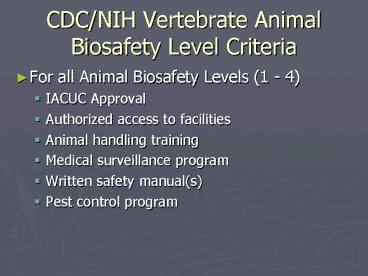CDCNIH Vertebrate Animal Biosafety Level Criteria - PowerPoint PPT Presentation
1 / 15
Title:
CDCNIH Vertebrate Animal Biosafety Level Criteria
Description:
CDC/NIH Vertebrate Animal Biosafety Level Criteria. For all Animal Biosafety Levels (1 - 4) ... Uniforms or scrub suits covered by solid-front gown ... – PowerPoint PPT presentation
Number of Views:92
Avg rating:3.0/5.0
Title: CDCNIH Vertebrate Animal Biosafety Level Criteria
1
CDC/NIH Vertebrate Animal Biosafety Level Criteria
- For all Animal Biosafety Levels (1 - 4)
- IACUC Approval
- Authorized access to facilities
- Animal handling training
- Medical surveillance program
- Written safety manual(s)
- Pest control program
2
CDC/NIH Verterbrate Animal Biosafety Level
Criteria
- For all Animal Biosafety Levels (1 - 4)
- no eating, drinking, smoking, touching face
- no food or drink storage within facilities
- minimize aerosols
- decontaminate work surfaces, equipment
- transport wastes in leak-proof covered containers
- handle sharps safely
3
CDC/NIH Verterbrate Animal Biosafety Level
Criteria
- For all Animal Biosafety Levels (1 - 4)
- Protective clothing recommended, not worn outside
facility - Facilities separate from general building traffic
- External doors self-closing/self-locking
- Animal room doors open inward, self-closing
- Water resistant, easily cleaned surfaces
(horizontal surfaces kept to a minimum)
4
CDC/NIH Verterbrate Animal Biosafety Level
Criteria
- For all Animal Biosafety Levels (1 - 4)
- Sealed, break resistant windows
- Floor drain traps filled with water or
disinfectant - No recirculation of exhaust air
- Rooms have negative pressure gradient to adjacent
hallway - Hand washing sink available in facility
- 180 F cage wash rinse temperature
- Adequate illumination
5
CDC/NIH Verterbrate Animal Biosafety Level
Criteria
- Animal Biosafety Level 2 (ABSL2)
- Restrict access to few as possible (advise
support staff of potential hazards) - Biohazard sign posted on animal room entrance
(hazard ID, contact info., entry requirements) - Immunizations, serum surveillance
- Labeled leakproof carriers, exterior disinfected
before transport (wastes, tissues, etc.) - Safe sharps policies (plasticware, safe sharps
devices, limited use of needles/syringes)
6
CDC/NIH Verterbrate Animal Biosafety Level
Criteria
- Animal Biosafety Level 2 (ABSL2)
- Limited to animals dedicated to work
- Exposures, spills reported immediately
- Gloves, gowns, uniforms or lab coats worn in
rooms (removed prior to exit) - Face protection (goggles, safety glasses, full
face shields, masks) selected on basis of risk - Biosafety cabinets used to confine aerosol
procedures
7
CDC/NIH Verterbrate Animal Biosafety Level
Criteria
- Animal Biosafety Level 2 (ABSL2)
- Filter top cages, cage dumping containment
stations used where appropriate - Autoclave available
- hand washing sink in animal room
8
CDC/NIH Verterbrate Animal Biosafety Level
Criteria
- Animal Biosafety Level 3 (ABSL3)
- Individuals at increased risk of infection not
allowed in facility - All wastes treated before disposal as regulated
biomedical waste (incineration recommended) - Specialized training provided and updated
- Cages autoclaved/decontaminated before bedding is
removed - Spill procedures posted
9
CDC/NIH Verterbrate Animal Biosafety Level
Criteria
- Animal Biosafety Level 3 (ABSL3)
- Uniforms or scrub suits covered by solid-front
gown - Face/eye, and where necessary, respiratory
protection worn by all who enter animal rooms - Boots, shoe covers, etc. worn when needed
- Consider use of containment ventilated cage
units, housing in biosafety cabinets, of filter
bonnets.
10
CDC/NIH Verterbrate Animal Biosafety Level
Criteria
- Animal Biosafety Level 3 (ABSL3)
- All procedures performed in biosafety cabinet
(wear respiratory protection if working outside
cabinet) - Consider clothes change room and shower
- Penetrations in rooms are sealed or capable of
being sealed - Hands-free sink near exit door
- Sink-trap filled with disinfectant after each use
11
CDC/NIH Verterbrate Animal Biosafety Level
Criteria
- Animal Biosafety Level 3 (ABSL3)
- Ducted exhaust ventilation system
- Exhaust discharge away from air intakes,
- Consider HEPA filtration of exhaust air
- Room airflow monitoring device (personnel verify
airflow direction upon entry) - Consider alarms for ventilation system failure
- Consider interlock of exhaust/supply systems to
avoid pressurization
12
CDC/NIH Verterbrate Animal Biosafety Level
Criteria
- Animal Biosafety Level 3 (ABSL3)
- Biosafety cabinets tested/certified annually
- Autoclave located near BL3 suite
- Vacuum system protected with HEPA filter if used
- Initial and annual verification of BL3 facility
design parameters - Consider additional facility enhancements as
needed (effluent decontamination, showers, etc)
13
CDC/NIH Verterbrate Animal Biosafety Level
Criteria
- Animal Biosafety Level 4 (ABSL4)
- Program includes post-exposure counseling and
prophylaxis - Site-specific biosafety manual prepared
- Double-door pass through autoclave
- Procedures performed in pairs
- Materials unrelated to work not allowed in
facility - Additional access control measures (security
guard)
14
CDC/NIH Verterbrate Animal Biosafety Level
Criteria
- Animal Biosafety Level 4 (ABSL4)
- Complete clothes change, personal shower upon
exit - All material in/out of facility through pass
through autoclave or disinfectant chamber - Autoclave door interlocked to prevent both open
simultaneously - Chart exposures, accidents/incidents, employee
absenteeism, appearance of related signs/symptoms
of infection
15
CDC/NIH Verterbrate Animal Biosafety Level
Criteria
- Animal Biosafety Level 4 (ABSL4)
- Serum samples analyzed at defined intervals
- Positive pressure suits or Class III biosafety
cabinet line - Very unique engineering requirements for BL4
laboratories (dedicated building within building
concept)

